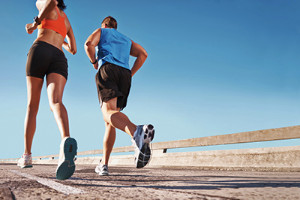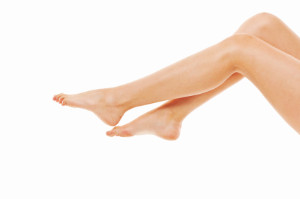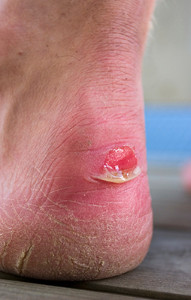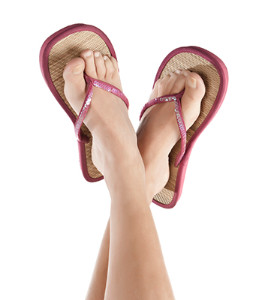Items filtered by date: June 2017
Tips for Healthy Feet
 Some of the most common complaints people have with their feet are pain, ingrown toenails, cracked heels, and fungus. When it comes to foot pain, many people are unaware that flat shoes can be just as bad as high heels. Flats do not offer any support for the foot, which can cause those who wear them to experience a lot of pain. Ingrown toenails are often the result of cutting your nails incorrectly; instead of cutting your nails in a rounded shape, you should cut them straight across. If you are trying to cure your cracked heels, you should know that they are caused by a lack of moisture in the feet. A helpful tip is to always moisturize and treat your feet the same way you would want to treat the skin on your face. If you want to get rid of toenail fungus, you should always treat it in its early stages, instead of letting it progress into something much worse. If you have any questions about any of these common foot issues, you should speak to a podiatrist right away.
Some of the most common complaints people have with their feet are pain, ingrown toenails, cracked heels, and fungus. When it comes to foot pain, many people are unaware that flat shoes can be just as bad as high heels. Flats do not offer any support for the foot, which can cause those who wear them to experience a lot of pain. Ingrown toenails are often the result of cutting your nails incorrectly; instead of cutting your nails in a rounded shape, you should cut them straight across. If you are trying to cure your cracked heels, you should know that they are caused by a lack of moisture in the feet. A helpful tip is to always moisturize and treat your feet the same way you would want to treat the skin on your face. If you want to get rid of toenail fungus, you should always treat it in its early stages, instead of letting it progress into something much worse. If you have any questions about any of these common foot issues, you should speak to a podiatrist right away.
Everyday foot care is very important to prevent infection and other foot ailments. If you need your feet checked, contact Dr. Mark Gagnon from Advanced Podiatry. Our doctor can provide the care you need to keep you pain-free and on your feet.
Everyday Foot Care
Often, people take care of their bodies, face and hair more so than they do for their feet. But the feet are a very important aspect of our bodies, and one that we should pay more attention to. Without our feet, we would not be able to perform most daily tasks.
It is best to check your feet regularly to make sure there are no new bruises or cuts that you may not have noticed before. For dry feet, moisturizer can easily be a remedy and can be applied as often as necessary to the affected areas. Wearing shoes that fit well can also help you maintain good foot health, as well as making it easier to walk and do daily activities without the stress or pain of ill-fitting shoes, high heels, or even flip flops. Wearing clean socks with closed shoes is important to ensure that sweat and bacteria do not accumulate within the shoe. Clean socks help to prevent Athlete’s foot, fungi problems, bad odors, and can absorb sweat.
If you have any questions please feel free to contact one of our offices located in Crestwood, Orland Park, and Summit, IL . We offer the newest diagnostic and treatment technologies for all your foot and ankle needs.
Ingrown Toenail Prevention
 Ingrown toenails occur when the corner or side of the toenail starts to grow into the soft flesh that surrounds it. As a result, one may experience pain, redness, swelling, and infection. People who have diabetes or poor circulation in their feet may be at a greater risk of developing an ingrown toenail. In order to prevent getting an ingrown toenail, you should try to cut your toenail straight across instead of in a rounded shape. Wearing shoes that fit properly may also help avoid the development of ingrown toenails. It is possible that the pain you experience from an ingrown toenail may spread to other parts of your feet, so it is crucial that you seek assistance from a podiatrist.
Ingrown toenails occur when the corner or side of the toenail starts to grow into the soft flesh that surrounds it. As a result, one may experience pain, redness, swelling, and infection. People who have diabetes or poor circulation in their feet may be at a greater risk of developing an ingrown toenail. In order to prevent getting an ingrown toenail, you should try to cut your toenail straight across instead of in a rounded shape. Wearing shoes that fit properly may also help avoid the development of ingrown toenails. It is possible that the pain you experience from an ingrown toenail may spread to other parts of your feet, so it is crucial that you seek assistance from a podiatrist.
Ingrown toenails can become painful if they are not treated properly. For more information about ingrown toenails, contact Dr. Mark Gagnon of Advanced Podiatry. Our doctor can provide the care you need to keep you pain-free and on your feet.
Ingrown Toenails
Ingrown toenails occur when a toenail grows sideways into the bed of the nail, causing pain, swelling, and possibly infection.
Causes
- Bacterial infections
- Improper nail cutting such as cutting it too short or not straight across
- Trauma to the toe, such as stubbing, which causes the nail to grow back irregularly
- Ill-fitting shoes that bunch the toes too close together
- Genetic predisposition
Prevention
Because ingrown toenails are not something found outside of shoe-wearing cultures, going barefoot as often as possible will decrease the likeliness of developing ingrown toenails. Wearing proper fitting shoes and using proper cutting techniques will also help decrease your risk of developing ingrown toenails.
Treatment
Ingrown toenails are a very treatable foot condition. In minor cases, soaking the affected area in salt or antibacterial soaps will not only help with the ingrown nail itself, but also help prevent any infections from occurring. In more severe cases, surgery is an option. In either case, speaking to your podiatrist about this condition will help you get a better understanding of specific treatment options that are right for you.
If you have any questions please feel free to contact one of our offices located in Crestwood, Orland Park, and Summit, IL . We offer the newest diagnostic and treatment technologies for all your foot and ankle needs.
How to Avoid Getting Blisters
 Although you may be excited to try on your brand new pair of shoes, you should be careful to avoid getting blisters while wearing them. Blisters are not only uncomfortable, but they often force you to walk in an unnatural way to compensate for the pain they cause. Fortunately, there are some tips you can follow to avoid getting blisters and having to deal with them while wearing your new kicks. One tip is to walk around in your new shoes at home prior to wearing them out in public. Wearing your shoes at home will help loosen them up so that the shoes are already broken-in when you are ready for regular use. Another tip is to make sure that you are wearing proper socks. While most people tend to wear ankle socks, they offer very little protection for your feet compared to longer ones. You should also make sure that the socks you wear are made up of a material that dries quickly. A material like cotton, which tends to stay damp for a while, may soften the skin and make you more susceptible to blisters.
Although you may be excited to try on your brand new pair of shoes, you should be careful to avoid getting blisters while wearing them. Blisters are not only uncomfortable, but they often force you to walk in an unnatural way to compensate for the pain they cause. Fortunately, there are some tips you can follow to avoid getting blisters and having to deal with them while wearing your new kicks. One tip is to walk around in your new shoes at home prior to wearing them out in public. Wearing your shoes at home will help loosen them up so that the shoes are already broken-in when you are ready for regular use. Another tip is to make sure that you are wearing proper socks. While most people tend to wear ankle socks, they offer very little protection for your feet compared to longer ones. You should also make sure that the socks you wear are made up of a material that dries quickly. A material like cotton, which tends to stay damp for a while, may soften the skin and make you more susceptible to blisters.
Blisters are prone to making everyday activities extremely uncomfortable. If your feet are hurting, contact Dr. Mark Gagnon of Advanced Podiatry. Our doctor can provide the care you need to keep you pain-free and on your feet.
Foot Blisters
Foot blisters develop as a result of constantly wearing tight or ill-fitting footwear. This happens due to the constant rubbing from the shoe, which can often lead to pain.
What Are Foot Blisters?
A foot blister is a small fluid-filled pocket that forms on the upper-most layer of the skin. Blisters are filled with clear fluid and can lead to blood drainage or pus if the area becomes infected.
How Do Blisters Form?
Blisters on the feet are often the result of constant friction of skin and material, usually by shoe rubbing. Walking in sandals, boots, or shoes that don’t fit properly for long periods of time can result in a blister. Having consistent foot moisture and humidity can easily lead to blister formation.
Prevention & Treatment
It is important to properly care for the affected area in order to prevent infection and ease the pain. Do not lance the blister and use a Band-Aid to provide pain relief. Also, be sure to keep your feet dry and wear proper fitting shoes. If you see blood or pus in a blister, seek assistance from a podiatrist.
If you have any questions, please feel free to contact one of our offices located in Crestwood, Orland Park, and Summit, IL . We offer the newest diagnostic and treatment technologies for all your foot care needs.
Why Flip Flops are Bad for Your Feet
 Wearing flip-flops excessively can cause your foot to become vulnerable. A lack of support may cause critical problems in the arch, forefoot, and heel of the foot, so it is important not to frequently wear flip-flops in order to avoid these issues. Other problems that may result from wearing flip-flops include: back pain, knee pain, stress fractures, and bone spurs. If you frequently wear flip-flops and are experiencing pain in these areas, you may want to seek help from a podiatrist.
Wearing flip-flops excessively can cause your foot to become vulnerable. A lack of support may cause critical problems in the arch, forefoot, and heel of the foot, so it is important not to frequently wear flip-flops in order to avoid these issues. Other problems that may result from wearing flip-flops include: back pain, knee pain, stress fractures, and bone spurs. If you frequently wear flip-flops and are experiencing pain in these areas, you may want to seek help from a podiatrist.
Flip-flops are not always the best choice of footwear. If you have any concerns about your feet or ankles, contact Dr. Mark Gagnon from Advanced Podiatry. Our doctor will assist you with all of your foot and ankle needs.
Flip-Flops and Feet
When the weather starts warming up, people enjoy wearing flip-flops. Flip-flops are comfortable, stylish, and easy to slip on and off; they're perfect for any summer beach goer. However, these shoes can cause harm to the feet.
How Can Flip-Flops Affect Me Long-Term?
- Ankle problems
- Hip problems
- Lower back problems
- Pain in the balls of the feet
- Problems with foot arches
- Changes in the way you walk
Are There Injuries Associated with Flip-Flops?
Yes. Since flip-flops are relatively weak and do not provide the same amount of support as sneakers, people who wear flip-flops regularly are more susceptible to injuries. On top of that, the open nature of the shoe makes your feet more prone to other problems, such as cuts and even infections. Common injuries and ailments include:
- Sprained ankles
- Blisters
- Infections
- Cuts and Scrapes
I like Wearing Flip-Flops. Are There Safe Alternatives?
When buying flip-flops, try to find ones that have sturdy soles and that are made of high-quality materials that will support for your feet. These flip-flops will cost more but will also last longer as a result.
If you have any questions please feel free to contact one of our offices located in Crestwood, Orland Park, and Summit, IL . We offer the newest diagnostic and treatment technologies for all your foot and ankle needs.
